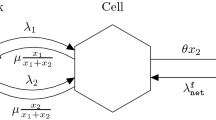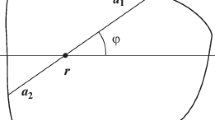Abstract
This paper considers large cellular mobile networks with dynamic channel allocation in which the arrival rates, holding times and handover probabilities for the different cells are identical. Such networks could model, for example, cellular networks in suburban areas. Different methods of analysing these networks are compared. These methods fall into two basic categories, those which approximate a network with a smaller finite network and those which consider the expected performance of a cell within an environment consisting of cells with identical properties. Simplifications of these methods which arise out of the reversibility of a symmetric cellular network are also discussed.
Similar content being viewed by others
References
J.P. Buzen, Computational algorithms for closed queueing networks with exponential servers, Comm. ACM 16(1973)527–531.
D.C. Cox and D.O. Reudink, Increasing channel occupancy in large-scale mobile radio systems: Dynamic channel reassignment, IEEE Trans. Veh. Tech. 22(1973)218–222.
D.E. Everitt and N.W. Macfadyen, Analysis of multi-cellular mobile ratiotelephone systems with loss, British Telecom Tech. J. 1(1983)37–45.
D.P. Gaver, P.A. Jacobs and G. Latouche, Finite birth-and-death models in randomly changing environments, Adv. Appl. Prob. 16(1984)715–731.
F.P. Kelly,Reversibility and Stochastic Networks (Wiley, 1979).
F.P. Kelly, Stochastic models of computer communication systems, J. Roy. Stat. Soc. Ser. B47(1985)379–395.
F.P. Kelly, Loss networks, Ann. Appl. Prob. 1(1991)319–378.
E.H. Lipper and M.P. Rumsewicz, Traffic analysis of co-channel interference in TDMA personal communications systems: Theoretical framework, Research Report, Bellcore (1992).
D.L. Pallant, A reduced load approximation for cellular mobile networks including handovers, Aust. Tel. Res. 26(1992)21–29.
D.L. Pallant and P.G. Taylor, Modelling handovers in cellular mobile networks with dynamic channel allocation, submitted.
D.L. Pallant and P.G. Taylor, Approximation of performance measures in cellular networks with dynamic channel allocation, Teletraffic Research Centre Report 9/1992, University of Adelaide (1992).
F. Posner, private communication to F.P. Kelly (1987).
P. Raymond, Performance analysis of cellular networks, IEEE Trans. Comm. 39(1991)1787–1793.
K. Sallberg, B. Stavenow and B. Eklundh, Hybrid channel assignment and reuse partitioning in a cellular mobile telephone system,37th IEEE Vehicular Technology Conf. (1987) pp. 405–411.
J. Walrand,An Introduction to Queueing Networks (Prentice-Hall, 1988).
W.H. Wang, E. Pinsky and K.K.Y. Ho, Performance analysis of some channel access schemes in cellular communication systems,Proc. INFOCOM '90, pp. 603–609.
W. Yue, Analytical methods to calculate the performance of a cellular mobile radio communication systems with hybrid channel assignment, IEEE Trans. Veh. Tech. 40(1991)453–460.
Author information
Authors and Affiliations
Rights and permissions
About this article
Cite this article
Pallant, D.L., Taylor, P.G. Approximation of performance measures in cellular mobile networks with dynamic channel allocation. Telecommunication Systems 3, 129–163 (1994). https://doi.org/10.1007/BF02110140
Received:
Accepted:
Issue Date:
DOI: https://doi.org/10.1007/BF02110140




